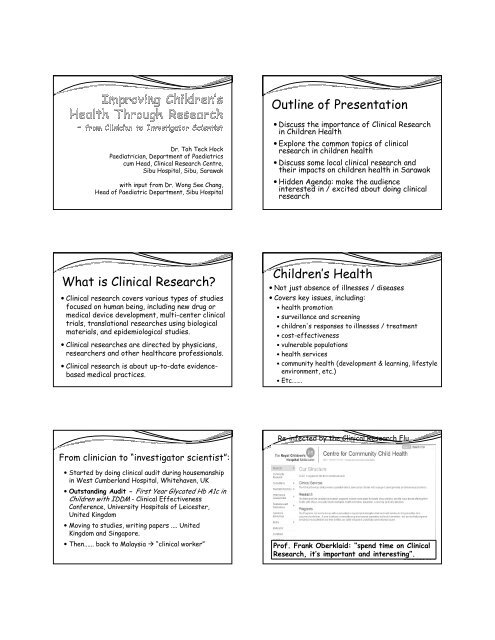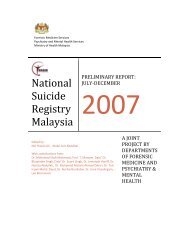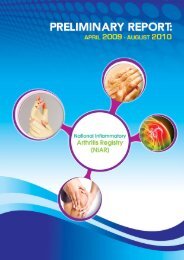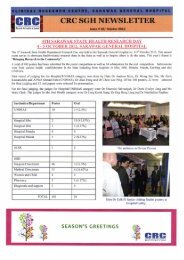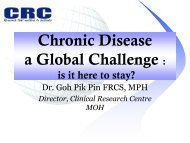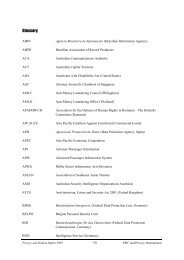Outline of Presentation What is Clinical Research? Children's Health
Outline of Presentation What is Clinical Research? Children's Health
Outline of Presentation What is Clinical Research? Children's Health
You also want an ePaper? Increase the reach of your titles
YUMPU automatically turns print PDFs into web optimized ePapers that Google loves.
Dr. Toh Teck Hock<br />
Paediatrician, Department <strong>of</strong> Paediatrics<br />
cum Head, <strong>Clinical</strong> <strong>Research</strong> Centre,<br />
Sibu Hospital, Sibu, Sarawak<br />
with input from Dr. Wong See Chang,<br />
Head <strong>of</strong> Paediatric Department, Sibu Hospital<br />
<strong>What</strong> <strong>is</strong> <strong>Clinical</strong> <strong>Research</strong>?<br />
� <strong>Clinical</strong> research covers various types <strong>of</strong> studies<br />
focused on human being, including new drug or<br />
medical device development, multi-center clinical<br />
trials, translational researches using biological<br />
materials, and epidemiological studies.<br />
� <strong>Clinical</strong> researches are directed by physicians,<br />
researchers and other healthcare pr<strong>of</strong>essionals.<br />
� <strong>Clinical</strong> research <strong>is</strong> about up-to-date evidencebased<br />
medical practices.<br />
From clinician to “investigator scient<strong>is</strong>t”:<br />
� Started by doing clinical audit during housemanship<br />
in West Cumberland Hospital, Whitehaven, UK<br />
� Outstanding Audit - First Year Glycated Hb A1c in<br />
Children with IDDM - <strong>Clinical</strong> Effectiveness<br />
Conference, University Hospitals <strong>of</strong> Leicester,<br />
United Kingdom<br />
� Moving to studies, writing papers .... United<br />
Kingdom and Singapore.<br />
<strong>Outline</strong> <strong>of</strong> <strong>Presentation</strong><br />
� D<strong>is</strong>cuss the importance <strong>of</strong> <strong>Clinical</strong> <strong>Research</strong><br />
in Children <strong>Health</strong><br />
� Explore the common topics <strong>of</strong> clinical<br />
research in children health<br />
� D<strong>is</strong>cuss some local clinical research and<br />
their impacts on children health in Sarawak<br />
� Hidden Agenda: make the audience<br />
interested in / excited about doing clinical<br />
research<br />
Children’s <strong>Health</strong><br />
� Not just absence <strong>of</strong> illnesses / d<strong>is</strong>eases<br />
� Covers key <strong>is</strong>sues, including:<br />
� health promotion<br />
� surveillance and screening<br />
� children's responses to illnesses / treatment<br />
� cost-effectiveness<br />
� vulnerable populations<br />
� health services<br />
� community health (development & learning, lifestyle<br />
environment, etc.)<br />
� Etc…….<br />
Re-infected by the <strong>Clinical</strong> <strong>Research</strong> Flu<br />
� Then...... back to Malaysia � “clinical worker” Pr<strong>of</strong>. Frank Oberklaid: “spend time on <strong>Clinical</strong><br />
<strong>Research</strong>, it’s important and interesting”.
Why <strong>Research</strong> in Children’s <strong>Health</strong><br />
� Early years <strong>of</strong> children's lives and significant impact on<br />
physical, behavioural & social development later in life.<br />
� Many childhood conditions & problems are preventable or<br />
can be improved if recogn<strong>is</strong>ed and managed early.<br />
� Best results = pr<strong>of</strong>essionals work in close partnership<br />
with parents who are supported & empowered to make the<br />
best choices for their children.<br />
� Translate up-to-date research and evidence (those shown<br />
to be effective and appropriate) into policy formulation at<br />
all levels (children / families, to school and community /<br />
country).<br />
Ref: http://www.rch.org.au/ccch/index.cfm?doc_id=10694<br />
Unique features <strong>of</strong> <strong>Clinical</strong> <strong>Research</strong> in Children’s <strong>Health</strong>*<br />
� Often involve multi-d<strong>is</strong>ciplinary team – various methodological<br />
approaches<br />
� Often aims to study full spectrum <strong>of</strong> child development &<br />
behaviour – reliability & validity<br />
� Often addresses more abstract <strong>is</strong>sues – e.g. community support,<br />
adjustment to illness (validated measures not available)<br />
� Ecological perspective (i.e. socio-cultural influences on child<br />
development and behaviour) – difficulty to measure, report<br />
accurately, and interpret/explain<br />
� Often relies on parent report – influenced by parents’ own<br />
perception <strong>of</strong> state<br />
� Advocacy <strong>is</strong>sues (protecting interest <strong>of</strong> the children)<br />
� Ethical <strong>is</strong>sues (confidentiality, d<strong>is</strong>closure, ability to consent, use<br />
<strong>of</strong> placebo)<br />
*<strong>Research</strong> Foundation, Methods & Issues in Developmental-Behavioural Paediatrics: D<br />
Schonfield, B Dreyer, Developmental-Behvaioural Paediatrics by Wolraich et al, 2008<br />
Main research themes in CCCH, RCH:<br />
� Development, behaviour and mental health<br />
� Hearing<br />
� Language, learning and literacy<br />
� Obesity & <strong>Health</strong>y Weight<br />
� Safety promotion and injury prevention<br />
� Children with additional needs<br />
*New Millennium Morbidities in Paediatrics<br />
<strong>What</strong> works? The need <strong>of</strong> evidence and the<br />
“best-buy” concept)<br />
� Like any other health care intervention, health<br />
promotion activities can do harm as well as good (e.g.<br />
inaccurate/incorrect information <strong>of</strong>fered, poor screening test for a<br />
variety <strong>of</strong> reasons, health information causing anxiety/guilt, etc.)<br />
� Ethical imperative to ensure that child health<br />
promotion activities are subjected to as robust an<br />
evaluation as any other health care intervention.<br />
� <strong>Research</strong> base in health promotion takes time to<br />
develop and absence <strong>of</strong> evidence <strong>of</strong> effect <strong>is</strong> not the<br />
same as evidence <strong>of</strong> absence <strong>of</strong> effect.<br />
Ref: D Hall & D Elliman: <strong>Health</strong> for All Children, 4 th ed. 2003, p 22-25<br />
Common / Important<br />
Children’s <strong>Health</strong><br />
<strong>Research</strong> Topics
Child and adolescent health and development<br />
topics in WHO<br />
�Development: The future <strong>of</strong> human societies depends on<br />
children being able to achieve their optimal physical growth &<br />
psychological development.<br />
�Rights: Life, survival, maximum development, access to health<br />
and access to health services are not just basic needs <strong>of</strong><br />
children and adolescents but are also fundamental human<br />
rights.<br />
�Prevention & care <strong>of</strong> illness:<br />
� Newborns, infants and children<br />
� IMCI (Integrated Management <strong>of</strong> Childhood Illness)<br />
� Adolescents<br />
� Nutrition (breastfeeding, complementary feeding, malnutrition,<br />
feeding in special circumstances such as HIV and etc.)<br />
Developmental-Behavioural Referrals in LKHMCC,<br />
Department <strong>of</strong> Paediatrics, Sibu Hospital (1998 –2010)<br />
2010: 66% <strong>of</strong> Department’s<br />
Clinic New Case Workload<br />
Children with Learning Difficulty?<br />
�Who are they?<br />
�<strong>What</strong> are their abilities?<br />
�Any associated problems?<br />
In Malaysia …<br />
� Probably Similar<br />
� MOH Paediatricians Meeting 2011 on<br />
obesity<br />
� Vaccination, child abuse, safety and<br />
injuries prevention<br />
� (Acute and chronic paediatric illnesses)<br />
� Different areas may have some<br />
differences and focus<br />
Increasing numbers <strong>of</strong> school children for<br />
medical assessment referred in 2010:<br />
� 94 primary one students referred for learning<br />
difficulty in LKHMCC<br />
� NKRA: Setiap kanak-kanak<br />
menguasai kemahiran asas<br />
literasi & numerasi selepas<br />
mengikuti 3 tahun pendidikan<br />
rendah pada akhir tahun<br />
2012.<br />
http://www.moe.gov.my/index.php?id=244&lang=my<br />
Slow Learner vs. Learning Difficulty:<br />
<strong>What</strong>’s in the names? – KPM / MOE<br />
Ciri-ciri:<br />
�Pencapaian pelajaran / akedemik berbeza.<br />
�Pendiam / tidak aktif / banyak cakap.<br />
�Sukar menerima arahan.<br />
�Tidak dapat berkomunikasi seperti kanak-kanak biasa.<br />
�Menyebut huruf 2 yg tidak tepat/salah, bertukar-tukar.<br />
�Meninggalkan huruf, sukukata & perkataan ketika<br />
membaca dan menul<strong>is</strong>.<br />
�Tul<strong>is</strong>an yang terlalu buruk / sukar dibaca.<br />
�Kekerapan kesalahan dalam ejaan, tanda bacaan.<br />
�Tanpa ketetapan / menaik dan menurun<br />
�Huruf terbalik / urutan dan arah yang salah<br />
�Tanpa ketetapan & ketentuan - jarak huruf / perkataan.<br />
�Saiz yg tak seragam/mencampuradukkan saiz–.<br />
�Idea tak berkembangan & penyusunan idea tak teratur.<br />
�Perbendaharaan kata terhad & tatabahasa yg tak tepat.<br />
Punca:<br />
•Baka<br />
•Tersekat pengalaman<br />
•Intelek yang rendah<br />
•Masalah emosi<br />
•Kekecewaan<br />
•Rasa rendah diri<br />
•Kemantangan yang lambat<br />
•Lemah daya ingatan<br />
•Mudah terganggu tumpuan<br />
•Kurang rangsangan<br />
•Faktor-faktor kesihatan<br />
•Persekitaran<br />
•Amalan makanan<br />
•Kesan semasa mengandung<br />
•Penyakit semasa<br />
pembesaran selepas lahir.<br />
•Ubat semasa mengandung.<br />
•Kemalangan.<br />
•Sosio-ekonomi.<br />
Unit Bermasalah Pembelajaran, Sektor Kurikulum, Bhg. Pengurusan Sekolah, Jabatan Pendidikan Khas, KPM<br />
SK Senai, Johor (http://www.sksenai.com/blogs/index.php/2008/07/23/lembam-slow-learner?blog=6)
Who’re these children with Learning Difficulties?<br />
Diagnos<strong>is</strong> (n = 93) –<br />
Male (n = 58) Female (n = 35) Total, p=0.24<br />
(n = 93)<br />
Borderline ID 23 (39.7%) 12 (34.3%) 35 (37.6%)<br />
Mild ID 11 (19.0%) 7 (20.0%) 18 (19.4%)<br />
SLD / Dyslexia 6 (10.3%) 4 (11.4%) 10 (10.8%)<br />
ADHD 10 (17.2%) 1 (2.9%) 11 (11.8%)<br />
ASD 3 (5.2%) 2 (5.7%) 5 (5.4%)<br />
Severe Lang. D<strong>is</strong>. - 3 (8.6%) 3 (3.2%)<br />
Bilateral SNHL 1 (1.7%) 1 (2.9%) 2 (2.2%)<br />
Low V<strong>is</strong>ion - 1 (2.9%) 1 (1.1%)<br />
Moderate ID 1 (1.7%) - 1 (1.1%)<br />
Incomplete 1* (1.7%) 2 † (5.7%) 3 (3.2%)<br />
Normal Cognition<br />
(no specific cause)<br />
2 (3.4%) 2 (5.7%) 4 (4.3%)<br />
*probable borderline intellectual d<strong>is</strong>ability; † probable dyslexia / language d<strong>is</strong>order<br />
Among those with ADHD, Borderline ID,<br />
Mild ID and SLD: - The Mental <strong>Health</strong><br />
Borderline / Significant Concerns<br />
Internalizing Externalizing<br />
Parental Report 25-50% 27-60 + %<br />
Teacher Report 42-70 + % 17-70 + %<br />
Other local researches that<br />
had / have potential to help<br />
improving children’s health<br />
How “smart” ‘re they? (Naglieri’s Non-verbal Ability Test)<br />
Scores Percentile Male<br />
NNAT percentile (n =53)<br />
Female<br />
(n =32)<br />
Total<br />
(n = 85)<br />
< 70 < 2 pc (ID) 5 (9.4%) 3 (9.4%) 8 (9.4%)<br />
71 – 80<br />
81 – 89<br />
90 – 110<br />
111- 119<br />
3 – 9 pc<br />
(Borderline)<br />
10 – 24 pc<br />
(Low Average)<br />
25 – 75 pc<br />
(Average)<br />
76 – 90 pc<br />
(High Average)<br />
11<br />
(20.8%)<br />
25<br />
(47.2%)<br />
13 (40.6%)<br />
5 (15.6%)<br />
8 (15.1%) 9 (28.1%)<br />
24<br />
(28.2%)<br />
30<br />
(35.3%)<br />
17<br />
(20.0%)<br />
4 (7.5%) 2 (6.3%) 6 (7.1%)<br />
> 120 > 91 pc - - -<br />
* 9 <strong>of</strong> original 94 children studied (9.6%) did not do the NNAT because<br />
“refused”, “unable to understand”, “did not concentrate”.<br />
If results replicated nationwide and show<br />
similar results, can adv<strong>is</strong>e / suggest:<br />
� MOH on training purposes (recogn<strong>is</strong>ing the<br />
differences) and guiding the follow up / clinic<br />
consultation<br />
� MOE on planning <strong>of</strong> resources and teachers –<br />
diagnos<strong>is</strong> are heterogenous and different /<br />
normal ability<br />
� Society – children with learning difficulty has<br />
associated co-morbidities and need special<br />
attention<br />
Vaccination & Children <strong>Health</strong><br />
� Newer Vaccines:<br />
� Chicken pox, Rotavirus, H1N1, Pneumococcal, Anticervical<br />
cancer, Hepatit<strong>is</strong> …<br />
� <strong>What</strong> <strong>is</strong> our country’s d<strong>is</strong>ease burden and types <strong>of</strong><br />
strain<br />
� Which vaccines – can our budget take all<br />
� Current Vaccination Schedule:<br />
� Effectiveness and uptake<br />
� Safety pr<strong>of</strong>ile<br />
� Cold chain practices
<strong>Research</strong> Partnership leading to introduction<br />
<strong>of</strong> JE vaccination schedule in Sarawak, 2001<br />
– Sibu Hospital, UNIMAS, Uni. <strong>of</strong> Liverpool, Sarawak State<br />
<strong>Health</strong> Department with the support <strong>of</strong> MOH Malaysia<br />
� SC Wong, MH Ooi, AR Abdullah, SY Wong, S Kr<strong>is</strong>hnan, PH Tio, PC Pek, BF<br />
Lai, A Mohan, J Muhi, A Kiyu, MT Arif, MJ Cardosa. A Decade <strong>of</strong><br />
Japanese Encephalit<strong>is</strong> Surveillance in Sarawak: 1997 TO 2006.<br />
Tropical Medicine and International <strong>Health</strong>; Volume 13 No 1 PP 52-55<br />
January 2008.<br />
� MH Ooi, P Lewthawaite, BF Lai, A Mohan, D Clear, L Lim, S Kr<strong>is</strong>hnan, T<br />
Preston, CH Chieng, PH Tio, SC Wong, MJ Cardosa and T Soloman. The<br />
Epidemiology, <strong>Clinical</strong> Features and Long Term Prognos<strong>is</strong> <strong>of</strong> Japanese<br />
Encephalit<strong>is</strong> in Central Sarawak, Malaysia 1997 to 2005, <strong>Clinical</strong><br />
Infectious D<strong>is</strong>eases 15 Aug 2008:47.<br />
Solving the mysterious HFMD - towards better<br />
children’s health.<br />
– <strong>Research</strong> Partnership among Sibu Hospital, UNIMAS<br />
& University <strong>of</strong> Liverpool<br />
- with support <strong>of</strong> Sarawak State <strong>Health</strong> Department<br />
and MOH Malaysia<br />
� M J Cardosa, S Kr<strong>is</strong>hnan, PH Tio, D Perera, SC Wong. Isolation <strong>of</strong> Subgenus B<br />
Adenovirus during a fatal outbreak <strong>of</strong> enterovirus 71-associated hand,<br />
foot, and mouth d<strong>is</strong>ease in Sibu, Sarawak. The Lancet, Vol 354, Sep 18, 1999.<br />
� MH Ooi, SC Wong, Y Podin, W Akin, S del Sel, A Mohan, CH Chieng, D Perera, D<br />
Clear, D Wong, E Blake, MJ Cardosa, T Solomon. Human Enterovirus 71<br />
D<strong>is</strong>ease in Sarawak, Malaysia: A Prospective <strong>Clinical</strong>, Virological and<br />
Molecular Epidemiological Study. <strong>Clinical</strong> Infectious D<strong>is</strong>eases 2007; 44:646–56<br />
� MH Ooi, SC Wong, A Mohan, Y Podin, D Perera, D Clear, S del Sel, CH Chieng,<br />
PH Tio, MJ Cardosa and T Solomon. Identification and validation <strong>of</strong> clinical<br />
predictors for the r<strong>is</strong>k <strong>of</strong> neurological involvement in children with hand,<br />
foot, and mouth d<strong>is</strong>ease in Sarawak. BMC Infectious D<strong>is</strong>eases 2009, 9:3.<br />
� Etc….<br />
Something simpler<br />
in the clinic<br />
� Between 15 April and 30 June 1997, 31 previously<br />
healthy infants and young children in Sarawak died<br />
after a short febrile illness against a background<br />
<strong>of</strong> an outbreak <strong>of</strong> HFMD in the State.<br />
� Sibu was badly affected during th<strong>is</strong> outbreak as 11<br />
<strong>of</strong> the death cases were reported from Sibu<br />
followed by Sarikei with 7 death cases.<br />
http://www.sarawak.health.gov.my/hfmd.htm<br />
<strong>Clinical</strong> <strong>Research</strong> Leading to Change<br />
http://www.sarawak.health.gov.my/hfmd.htm<br />
<strong>Health</strong> Education Activities<br />
� <strong>Health</strong> education pamphlets, radio talks<br />
Enforcement <strong>of</strong> Leg<strong>is</strong>lation<br />
� Delegation <strong>of</strong> authority by State <strong>Health</strong> Director to Div<strong>is</strong>ional<br />
<strong>Health</strong> Officers to close tadika/taska and kindergartens using<br />
Section 7(2) Protection, Public <strong>Health</strong> Ordinance 1999 Sarawak.<br />
Interagency Ass<strong>is</strong>tance<br />
� Sanitary inspection, physical examination <strong>of</strong> all enrolled children at<br />
� Recommend for immediate closure <strong>of</strong> all primary schools for 14<br />
days, should the number <strong>of</strong> cases continue to increase in the State<br />
Management Protocols<br />
� Observation and <strong>is</strong>olation; and strict universal precautions<br />
� MH Ooi, SC Wong, P Lewthwaite, MJ Cardosa, T Solomon. <strong>Clinical</strong><br />
Features, Diagnos<strong>is</strong> and Management <strong>of</strong> Enterovirus 71.<br />
www.thelancet.com/neurology Vol 9 Nov 2009.<br />
The developmental outcome <strong>of</strong> neonates<br />
with PPHN managed with MgSO 4 –<br />
preliminary results<br />
� 2004-2007: 33 out <strong>of</strong> 36 survived<br />
� 16 contactable so far (early 2011)<br />
� 13 assessed:<br />
� 1 has hearing impairment<br />
� 2 has intellectual d<strong>is</strong>ability<br />
� 9 showing weakness in language development despite<br />
“normal” overall ability<br />
� If proven: need to emphasize and advice parents re<br />
early language development<br />
Ref: Toh TH, Chieng CH, Wong SC; 2011
�Contributing towards<br />
international health data<br />
�Many examples – here <strong>is</strong> one<br />
Toh Teck Hock, Nurhilda Abdullah, Chua Soh Yian, Muhamad<br />
Ra<strong>is</strong> Abdullah, Islia bt Nahazatul, Chieng Lee Ong. BMI, BP,<br />
V<strong>is</strong>ual Acuity and Hearing Status <strong>of</strong> Special Olympics<br />
Athletes in Sarawak. In press.<br />
Methodology:<br />
<strong>Health</strong> data were collected by trained health<br />
pr<strong>of</strong>essionals under HAP held in conjunction with<br />
Sarawak Special Olympics State Games between<br />
17-18 April 2010.<br />
N = 73 for children (less than 18 years)<br />
BP in children<br />
How does th<strong>is</strong> project helps?<br />
� Contribution towards international data<br />
for people with intellectual d<strong>is</strong>ability<br />
� Helps bring awareness among adult caregivers<br />
� Primary intervention as well as secondary<br />
/ tertiary interventional programmes<br />
Conclusion<br />
� <strong>Clinical</strong> <strong>Research</strong> <strong>is</strong>:<br />
� a world-wide trend (and “flu-like”)<br />
� about evidence-based practice<br />
� doable at any level / setting no matter<br />
how simple / soph<strong>is</strong>ticated<br />
� <strong>Clinical</strong> <strong>Research</strong> in children health does<br />
improve the care clinicians provide<br />
Many other potential topics<br />
�Obesity and interventional studies<br />
�Environmental effects on children<br />
development and behaviours<br />
�Child abuse and at r<strong>is</strong>k group<br />
�Parenting<br />
�………<br />
A Key Event <strong>of</strong> National Early Childhood Intervention Council


